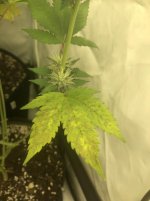InsaneMembrane
Member
So I had two things going on at the same time
1) watered with pH 8.0 water
2) raise in humidity, 70%
what are we seeing here ?



additional info:
Symptoms appeared almost over night on bottom leaves and started moving upwards.
im using spring water with same soil mix for years, had heavy rains which drove my water to 8.0 (normaly at 7.4). Soil mix always buffered to 6.5. These symptoms appeared right after the rains as I forgot they will spike my water pH like they usually do. My guess is this is a P and Ca and maybe a micro lockout due to a sudden pH swing.
at the same time due to rains my rH spiked to 70% which means the transpiration stalled so my second guess is overwatering. bad transpiration with LED lights can be scary.
which is more likely?
Other info:
35 days of flower on a 8 week strain
600W LED
20L / 5gal fabric pots
Custom super soil performing well over the years for me so i wont go into what’s inside, im quite certain this must be pH / watering related
Actions taken:
let them go a day and a half longer than usual without water and then I watered with 6.4 pHed water. Seems like it has stopped progressing but I am not sure yet.
thanks fellow growers!
1) watered with pH 8.0 water
2) raise in humidity, 70%
what are we seeing here ?
additional info:
Symptoms appeared almost over night on bottom leaves and started moving upwards.
im using spring water with same soil mix for years, had heavy rains which drove my water to 8.0 (normaly at 7.4). Soil mix always buffered to 6.5. These symptoms appeared right after the rains as I forgot they will spike my water pH like they usually do. My guess is this is a P and Ca and maybe a micro lockout due to a sudden pH swing.
at the same time due to rains my rH spiked to 70% which means the transpiration stalled so my second guess is overwatering. bad transpiration with LED lights can be scary.
which is more likely?
Other info:
35 days of flower on a 8 week strain
600W LED
20L / 5gal fabric pots
Custom super soil performing well over the years for me so i wont go into what’s inside, im quite certain this must be pH / watering related
Actions taken:
let them go a day and a half longer than usual without water and then I watered with 6.4 pHed water. Seems like it has stopped progressing but I am not sure yet.
thanks fellow growers!










